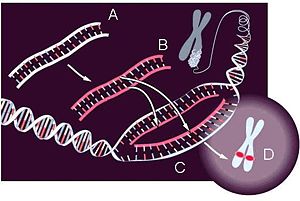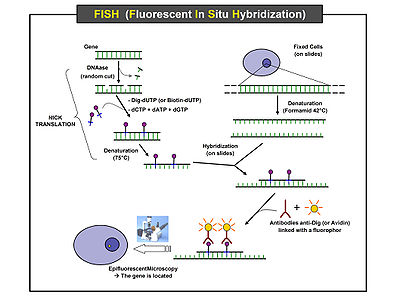- Fluorescent in situ hybridization
-
Hybridation fluorescente in-situ
 Pour les articles homonymes, voir FISH.Technique de l'hybridation fluorescente in situ. En A : sonde. B : sonde colorée à l'aide d'un fluorochrome. C: hybridation avec l'ADN nucléaire. D: apparence du chromosome métaphasique où la sonde s'est fixée.
Pour les articles homonymes, voir FISH.Technique de l'hybridation fluorescente in situ. En A : sonde. B : sonde colorée à l'aide d'un fluorochrome. C: hybridation avec l'ADN nucléaire. D: apparence du chromosome métaphasique où la sonde s'est fixée.
L'Hybridation fluorescente in situ (en anglais Fluorescent in situ hybridization ou FISH) est une technique de biologie moléculaire d'hybridation in situ utilisant des sondes marquées à l'aide d'un marqueur fluorescent et utilisées sur des coupes en microscopie.
Ces sondes peuvent être utilisées sur de l'ADN ou de l'ARN (sonde ADN), ou sur des protéines (sonde anticorps).
Le FISH est une technique de cytogénétique permettant de voir des élèments à l'intérieur de la cellule.
Utilisée en médecine en association à la réalisation d'un caryotype, elle permet par exemple la recherche de microdélétions caractéristiques du syndrome de Williams ou du syndrome de Jacobsen. Elle permet de différencier un syndrome CHARGE d'un syndrome de microdélétion 22q11, tous deux résultant en des problèmes cardiaques.
Utilisée en conjonction avec d'autres techniques de biologie moléculaire (PCR, DGGE...), la technique FISH permet de faire des études de biologie telles l'étude de la biodiversité des espèces du picoplancton photosynthétique. L'hybridation in situ utilise des sondes fluorescentes reconnaissant des taxons bien précis, par exemple une espèce, un genre ou une classe.
Une variante de la technique s'appelle CARD-FISH pour catalyzed reporter deposition fluorescent in situ hybridization.
Article connexe
Voir aussi
- Marta de Menezes, une artiste portugaise réalisant des films utilisant la technique du FISH.
Catégorie : Technique de biologie moléculaire
Wikimedia Foundation. 2010.


